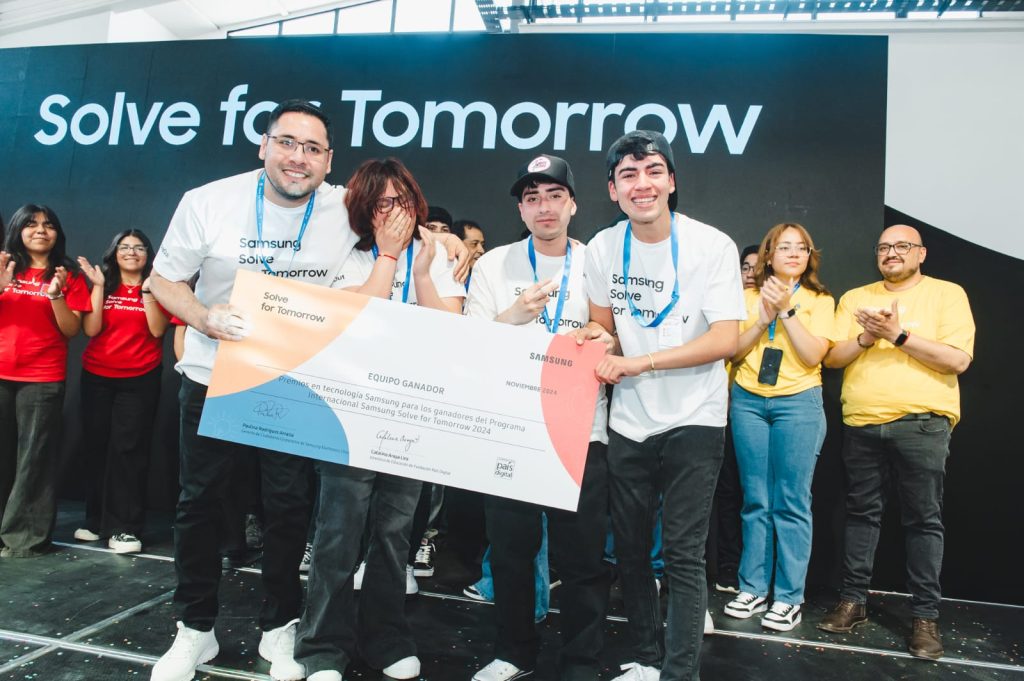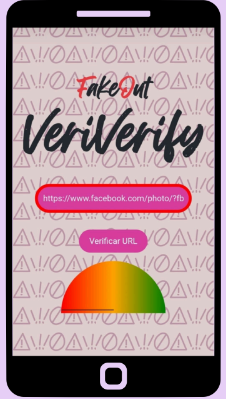The fight against disinformation and fake news is a global challenge. According to a study that was published by the University of Chile in 2021, in Chile alone, 5 million people shared so-called ‘news’ without checking to see whether it was true. In light of this grave scenario, a group of students asked themselves: what can be done to help people properly inform themselves and share information safely on the internet?
As an answer to that question, the project Fake Out was born, winner of Solve for Tomorrow 2024 in Chile. Three young people from middle school (in Chile, the penultimate year of technical vocational education) of the Juan Terrier Daily Bicentennial Polytechnic Institute, in the city of Maule, created the VeriVerify app. It is a simple tool that indicates with colors if a news story on the internet is true or not, making conscious use of artificial intelligence (AI). The project was mediated by the teacher Rogers Méndez, who also mediated the winning project in the 2022 edition of the Solve for Tomorrow program.
Méndez is a specialist in Design Thinking, an active methodology that forms the basis of Project-based Learning (PBL), adopted by the Institute’s courses. “It is a methodology focused on problem solving in a creative and attractive way, because its intention is to include the students and the community in the development of a prototype, a product or a service which solves this problem”, explains the teacher.
Although it is a global problem, the students noticed the results of disinformation within their own reality. “There were many arguments and problems in terms of coexistence among the school’s students due to the circulation of fake news. In addition, within the context of their own families they realized that this also affected the adults, particularly the older ones”, added the teacher.
During project’s definition stage, the group of students carried out a thorough research process on a number of fronts. They produced a comprehensive report regarding how the problem of disinformation affects people both in Chile and in Latin America as a whole. Part of the research was based on interviews with famous journalists and communication specialists. The purpose of all this was to understand how communication vehicles are dealing with the crisis. The students also conducted interviews with the community, in an attempt to understand what motivates someone to share a story without first verifying it.
The students’ research was also guided by the Digital Transformation Goals (DTG), the country’s macro policy for digital transformation, the goal of which is to reduce the digital divide, and use education as a tool for a more conscious and secure use of networks. The group’s conclusion was that the best way to resolve this problem was to create some kind of program or application that would make it possible to make a clear distinction between news that was true and that which was false, and make this knowledge available for everyone.

Possible ideas, using the resources that are available
According to Professor Méndez’s experience, one of the biggest problems in the definition stage of any STEM (Science, Technology, Engineering and Mathematics) project is the desire to come up with a really significant prototype, something which has never been done before. The Fake Out group carried out intense brainstorming sessions making use of the research that already existed, and considering what was possible with the knowledge of the institute’s programming course.
“All the ideas were ones that involved technology,” recalls Méndez. “One of them was the idea to create a digital community, where people could freely choose news stories and discuss their truthfulness; there were also an augmented reality app, a digital education tool, and a proper app for journalists.”
After a great deal of wishful thinking, the group decided to keep their feet on the ground. The result of this was the VeriVerify app: which uses artificial intelligence to identify a link’s accuracy. Based on existing data, the app has a meter: if the news is false, it turns red; if true, it turns green. The project was developed using tools such as React, JavaScript and Firebase, with the latter storing a large amount of data to feed the robot that makes the distinction. Everything was free of charge, with knowledge belonging to the school curriculum.
To input data to the database, students trained artificial intelligence. It was filled with official news, from reliable newspaper pages and official government media pages. For fake news, they posted articles that were on Facebook and other social media. The information robot began to identify the patterns that made distinction possible.

A communication project with shy young people
The school community became a potential target audience for testing VeriVerify. It demonstrated the articulation capacity of an institution that has experience with organizing learning communities with others who are also part of the Educational Foundation Comeduc. The project was presented as part of the programming course, and then to students and teachers from other of the institute’s workshops, growing the audience. It was also presented to programming experts from other institutions that make up the Foundation.
“With each test, the feedback gets better. Most of the feedback was related to aesthetic issues, because in order for the app to stand out it is not enough for it to work, it also has to be attractive. All this feedback from their own colleagues, specialist teachers and experts in the field enabled the students to see how the project was getting stronger”, says the teacher.
However, the real challenge came to light when the students were pitching and presenting their project, namely their shyness. The boys had many skills, but public speaking was not one of them. That’s exactly why Méndez chose them: they had an optimal idea and just needed a chance to stone their presentation. “Sometimes really powerful ideas come from people who lack the ability to express them, or who are not given the opportunity to do so, and these ideas end up being lost because this gap is a very clear one”.
So, what the group focused on was not the technical skills, which it had in abundance, but rather soft skills, which Méndez honed with motivational and supportive work. These young people, who had initially been very shy, trained so much that they were even able to make a funny video, in which they clearly explain what the application is all about, as well as making presentations for the Educational Foundation Comeduc.
The award they received in the Solve for Tomorrow program together with the recognition of their peers represented a life-changing moment for these young people. “Today you see them playing a much more active role not only in activities related to innovation, but also in school coexistence campaigns, where they act as spokesmen. They continue to take the lead in robotics and innovation processes, but now they are leading workshops for the network. They took on this role, empowered themselves and are now playing more important roles in their processes. So it’s wonderful!” concludes Méndez.
“Sometimes really powerful ideas come from people who lack the ability to express them, or who are not given the opportunity to do so, and these ideas end up being lost because this gap is a very clear one”.




